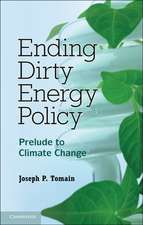How Much Is Clean Air Worth?: Calculating the Benefits of Pollution Control
Autor Ari Rabl, Joseph V. Spadaro, Mike Hollanden Limba Engleză Hardback – 9 iul 2014
Preț: 476.40 lei
Preț vechi: 535.28 lei
-11% Nou
Puncte Express: 715
Preț estimativ în valută:
91.17€ • 94.83$ • 75.27£
91.17€ • 94.83$ • 75.27£
Carte tipărită la comandă
Livrare economică 15-29 aprilie
Preluare comenzi: 021 569.72.76
Specificații
ISBN-13: 9781107043138
ISBN-10: 1107043131
Pagini: 695
Ilustrații: 135 b/w illus. 98 tables
Dimensiuni: 157 x 236 x 35 mm
Greutate: 1.11 kg
Ediția:New.
Editura: Cambridge University Press
Colecția Cambridge University Press
Locul publicării:New York, United States
ISBN-10: 1107043131
Pagini: 695
Ilustrații: 135 b/w illus. 98 tables
Dimensiuni: 157 x 236 x 35 mm
Greutate: 1.11 kg
Ediția:New.
Editura: Cambridge University Press
Colecția Cambridge University Press
Locul publicării:New York, United States
Cuprins
Foreword; Preface; Acknowledgements; 1. Introduction; 2. Tools for environmental impact and damage assessment; 3. Exposure-response functions for health impacts; 4. Impacts of air pollution on building materials; 5. Agriculture, forests and ecosystems; 6. Other impacts; 7. Atmospheric dispersion of pollutants; 8. Multimedia pathways; 9. Monetary valuation; 10. The costs of climate change; 11. Uncertainty of damage costs; 12. Key assumptions and results for cost per kg of pollutant; 13. Results for power plants; 14. Results for waste treatment; 15. Results for transport; 16. Lessons for policy makers; Appendix A. Nomenclature, symbols, units and conversion factors; Appendix B. Description of the RiskPoll software; Appendix C. Equations for multimedia model of Chapter 5; Index.
Recenzii
'The economic costs of pollution are large, but uncertain. This book, from some of the leading analysts in the field, provides a much-needed accessible description of the methods for calculating externalities, the results and their policy implications. The authors clearly address the relevant uncertainties and ethical underpinnings, bringing a balanced approach to complex issues that are so often distorted by vested interests.' Nick Eyre, Jackson Senior Research Fellow in Energy Policy, University of Oxford
'Understanding the hidden or external costs of the energy system - primarily to human health and the environment - is one of the critical needs for making informed choices about this pervasive economic sector. I can think of few individuals as qualified as Ari Rabl, Joseph Spadaro and Mike Holland to take up the challenge. In this complex and contentious domain, they provide a thorough description of the best methods for estimating damage costs, richly illustrated with examples. While one may not agree with all of their analytic choices, one cannot disagree with their unrelenting emphasis on the value for responsible decision making of comprehensive cost estimates that are roughly right, and the need to understand the scientific and economic principles to judge which of many estimates that different analysts may put forward merit attention.' James K. Hammitt, Harvard University
'Ari Rabl and his co-authors have successfully tackled an extremely difficult subject, the estimation of damage costs associated with environmental pollution. Decisions regarding what level of environmental quality to provide are both vital and unavoidable (the decision to do nothing is itself a decision, with benefits and costs). With this volume to guide them, decision-makers will be virtually certain to make better decisions in this important area than would be the case in the absence of the information the authors provide. State-of-the-art methodologies are clarified with the aid of numerous important examples, hence anyone with a serious interest in the environment will benefit enormously from this book.' Philip E. Graves, University of Colorado
'Understanding the hidden or external costs of the energy system - primarily to human health and the environment - is one of the critical needs for making informed choices about this pervasive economic sector. I can think of few individuals as qualified as Ari Rabl, Joseph Spadaro and Mike Holland to take up the challenge. In this complex and contentious domain, they provide a thorough description of the best methods for estimating damage costs, richly illustrated with examples. While one may not agree with all of their analytic choices, one cannot disagree with their unrelenting emphasis on the value for responsible decision making of comprehensive cost estimates that are roughly right, and the need to understand the scientific and economic principles to judge which of many estimates that different analysts may put forward merit attention.' James K. Hammitt, Harvard University
'Ari Rabl and his co-authors have successfully tackled an extremely difficult subject, the estimation of damage costs associated with environmental pollution. Decisions regarding what level of environmental quality to provide are both vital and unavoidable (the decision to do nothing is itself a decision, with benefits and costs). With this volume to guide them, decision-makers will be virtually certain to make better decisions in this important area than would be the case in the absence of the information the authors provide. State-of-the-art methodologies are clarified with the aid of numerous important examples, hence anyone with a serious interest in the environment will benefit enormously from this book.' Philip E. Graves, University of Colorado
Notă biografică
Descriere
A comprehensive reference on the main methodologies used to calculate the benefits of pollution control, with worked examples.























